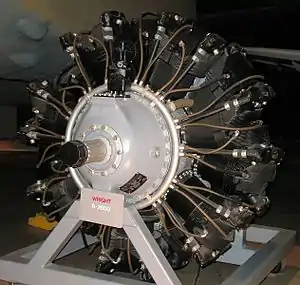Wright R-2600 Twin Cyclone
The Wright R-2600 Cyclone 14 (also called Twin Cyclone) was an American radial engine developed by Curtiss-Wright and widely used in aircraft in the 1930s and 1940s.
| R-2600 | |
|---|---|
 | |
| Wright R-2600 Cyclone radial engine | |
| Type | Radial engine |
| National origin | United States |
| Manufacturer | Wright Aeronautical |
| First run | 1935 |
| Major applications | Curtiss SB2C Helldiver Douglas A-20 Havoc Grumman TBF Avenger Martin PBM Mariner North American B-25 Mitchell |
| Number built | >50,000 |
| Developed from | Wright R-1820 |
History
In 1935, Curtiss-Wright began work on a more powerful version of their successful R-1820 Cyclone 9. The result was the R-2600 Twin Cyclone, with 14 cylinders arranged in two rows. The 1,600 hp (1,200 kW; 1,600 PS) R-2600-3 was originally intended for the C-46 Commando (being fitted to the prototype CW-20A). It was also the original engine choice for the F6F Hellcat; a running change (one which would not stop production) for the CW-20A, and one in late April 1942 for the second XF6F-1, led to the adoption of the 2,000 hp (1,500 kW; 2,000 PS) Pratt & Whitney R-2800 Double Wasp in the R-2600's place for both designs.
The Twin Cyclone went on to power several important American World War II aircraft, including the A-20 Havoc, B-25 Mitchell, TBF Avenger, SB2C Helldiver, and the PBM Mariner.
Over 50,000 R-2600s were built at plants in Paterson, New Jersey, and Cincinnati, Ohio.
Variants
- R-2600-1 - 1,600 hp (1,194 kW)
- R-2600-3 - 1,600 hp (1,194 kW)
- R-2600-6 - 1,600 hp (1,194 kW)
- R-2600-8 - 1,700 hp (1,268 kW)
- R-2600-9 - 1,700 hp (1,268 kW)
- R-2600-12 - 1,700 hp (1,268 kW)
- R-2600-13 - 1,700 hp (1,268 kW)
- R-2600-19 - 1,600 hp (1,194 kW), 1,660 hp (1,237 kW)
- R-2600-20 - 1,700 hp (1,268 kW), 1,900 hp (1,420 kW)
- R-2600-22 - 1,900 hp (1,420 kW)
- R-2600-23 - 1,600 hp (1,194 kW)
- R-2600-29 - 1,700 hp (1,268 kW), 1,850 hp (1,380 kW)
- GR-2600-A5B - 1,500 hp (1,118 kW), 1,600 hp (1,194 kW), 1,700 hp (1,268 kW)
- GR-2600-A71 - 1,300 hp (969 kW)
- GR-2600-C14 - 1,750 hp (1,304 kW)
Applications

- Boeing 314 Clipper
- Brewster SB2A Buccaneer
- Curtiss SB2C Helldiver
- Douglas A-20 Havoc
- Douglas B-23 Dragon
- Grumman F6F Hellcat (XF6F-1 & -2 prototypes only, pre-April 1942)
- Grumman TBF Avenger
- Lioré et Olivier LeO 451
- Martin Baltimore
- Martin PBM Mariner (versions prior to Double Wasp-powered PBM-5)
- Miles Monitor
- North American B-25 Mitchell
- Vultee A-31 Vengeance
Specifications (GR-2600-C14BB)
Data from Jane's.[1]
General characteristics
- Type: 14-cylinder supercharged air-cooled two-row radial engine
- Bore: 6 1⁄8 in (155.6 mm)
- Stroke: 6 5⁄16 in (160.3 mm)
- Displacement: 2,604 in3 (42.7 L)
- Length: 62.06 in (1,576 mm)
- Diameter: 55 in (1,397 mm)
- Dry weight: 2,045 lb (930 kg)
Components
- Valvetrain: Two pushrod-actuated valves per cylinder with sodium-cooled exhaust valve
- Supercharger: Single-stage two-speed centrifugal type supercharger, impeller diameter 11 in (280 mm), blower ratio 7.06:1 at slow speed and 10.06:1 at high speed
- Fuel system: Stromberg PR48A downdraft carburetor with automatic mixture control
- Oil system: Dry sump with one pressure pump and two scavenge pumps
- Cooling system: Air-cooled
Performance
- Power output:
- 1,750 hp (1,305 kW) at 2,600 rpm at 3,200 ft (975 m) military power
- 1,450 hp (1,080 kW) at 2,600 rpm at 15,000 ft (4,575 m) military power
- Specific power: 0.67 hp/in³ (30.6 kW/L)
- Compression ratio: 6.9:1
- Power-to-weight ratio: 0.86 hp/lb (1.40 kW/kg)
See also
- Gunderson Do-All Machine - incorporates an R-2600 into an educational network of machines that is also kinetic art.
Related development
- Wright Cyclone family
- Wright R-1300 Cyclone 7
- Wright R-1820 Cyclone 9
- Wright R-3350 Duplex-Cyclone
- Hispano-Suiza 14Aa
Comparable engines
- BMW 801
- Bristol Hercules
- Fiat A.74
- Gnome-Rhône 14N
- Mitsubishi Kasei
- Pratt & Whitney R-2800
- Shvetsov ASh-82 - derived and metricated from Wright Aeronautical radial engine designs[2]
Related lists
References
| Wikimedia Commons has media related to Wright R-2600. |
Notes
- Jane's 1998, p. 317.
- Witold Liss (1967). The Lavochkin La 5 & 7, number 149. Profile publications Ltd., P.O. Box, 1a North Street, Leatherhead, Surrey, UK. p. 3
Bibliography
- Gunston, Bill. World Encyclopedia of Aero Engines: From the Pioneers to the Present Day. 5th edition, Stroud, UK: Sutton, 2006. ISBN 0-7509-4479-X
- White, Graham. Allied Aircraft Piston Engines of World War II: History and Development of Frontline Aircraft Piston Engines Produced by Great Britain and the United States During World War II. Warrendale, Pennsylvania: SAE International, 1995. ISBN 1-56091-655-9
- Jane's Fighting Aircraft of World War II. London. Studio Editions Ltd, 1998. ISBN 0-517-67964-7
